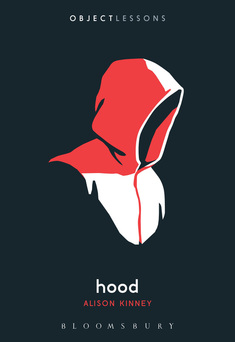|
Bear with me y’all, I’m trying something new here. Each month, I will discuss a different book and a bottle of something delicious. Drink stuff, learn stuff.
I wish I had some Armagnac.
I’m out of Armagnac. It’s the only thing I can think of that can stand up to the depth and provocative structured elegance of Alison Kinney’s Hood. And I’m not just saying that because we’re friends and she invited me to a “Lord of the Rings” trilogy viewing party (complete with themed food!). Naw, I respect Alison far too much for that. Her writing speaks for itself. The very first chapter includes lines such as:
“To accurately identify the sources of authority, danger, terror, and difference, when so much turns up on a flap of fabric, is the problem of the hood itself.”
The experience of a good Armagnac similarly makes one stop and reconsider WHAT JUST HAPPENED. Aromas of baked pear, quince, roast chestnuts, prunes, and even caramel reach out of the glass and grab your nose before the first sip. Did you smell the vanilla, too? And what about that note of candied pineapple? The first sip or two delivers on the complexity. Those aromas turn into flavors on the palate, and still there is more to discover. There are flowers, slightly dried, and hints of cocoa, toffee, buerre blanc, and perhaps other things that call to mind the colors yellow, orange, and gold. The finish? Warm and cozy, but strong, kind of like a really great easy chair. You sink into it, sigh, and relax.
Yep, there’s a lot going on in the glass, just as there is a lot happening in Kinney’s sentences. In that first example from Chapter 1, she somehow managed to connect the present with the distant past, the banal with the sacred, civility and the arts with rebellion and destruction. Now, I know that at least a metric ton of research, time, and excellent writing went into the making of Hood. I also know that Armagnac is carefully produced, often according to family tradition, from a blend of grapes. Ugni blanc makes up most of the blend, but there can be up to 11 other white grapes in the mix. Now, if that ain’t a recipe for nuance and complexity, I don’t know what is.
Armagnacs tend to reflect the rustic nature of their homeland, but that’s not to say there’s no finesse. After all, duck confit and foie gras are traditional foods in Gascony—these folks have a handle on finesse. There’s a smoothness to a good Armangnac. The flavors are integrated and finely honed, kind of like that easy chair I talked about earlier. Or, the ideas in a thoroughly well-crafted book of history, like Hood.
Hood is just one book in Bloomsbury’s "Object Lessons" series, which includes titles such as Bookshelf, Drone, and Hair. While I've only read Hood so far, I’m willing to bet the other books and essays are just as scintillating. Armagnac is available in a few ways. It may be blended from several grape vintages and released under special names that denote how much time the youngest portion of the blend has spent in barrel (i.e VS, VSOP, Napoléon, XO, and XO Premium). It can also be labeled vintage. Vintage Armagnac must be made from grapes blended in a single year, and aged for at least 10 years in a barrel.
0 Comments
Oh sure, there will be some colored folk about. The host, Chris Rock, for one. And maybe a few of those great actors everyone talks about, like Denzel Washington, Forrest Whitaker, and Lupita Nyong'o. But nope, nobody who's up for an award THIS year. In fact, for the second year in a row, every actor nominated for an Oscar award is White, despite the critical praises of such films as "Beasts of No Nation," "Straight Outta Compton," and "Creed" (and also, "Concussion," which everyone seems to have just plain forgotten about, as though they too had been hit repeatedly in the head).
Reactions range from wide-eyed puzzlement to rage and resigned bitterness about the glaring omission of films led by Africans or African Americans. "Is it the members who vote on the Oscars, the films, the campaigns behind them or something else?" one recent NY Times article read. “Industry critics were asking how filmdom’s top awards could be so narrowcast a second year in a row.” Jada Pinkett and Spike Lee are calling for a boycott.
But hey, why dwell on the rampant inequality and racism around us? When life gives you lemons, use ‘em to garnish a drink. So, in honor of the great Oscar “White Out” of 2016, and the inevitable desire for many drinks as Hollywood congratulates itself for being the White BET Awards, here are a few cocktails based on white, clear, or light-colored alcoholic liquors. Let’s start at with the host, shall we?
Chris on the Rocks
This vermouth cocktail is clean and smooth, with a touch of citrus and elderberry on the nose and a kick you may not see coming, kind of like Oscar host Chris Rock’s comedic style.
Straight Outta Consideration
For this cocktail, inspired by the Klondike Strike and classic gin and juice, I chose Remy Martin, a longtime connection of Dr. Dre and Ice Cube and orange juice. Just who decided that “popular” movies are not worthy Oscar consideration anyway? “Straight Outta Compton,” despite the glaring failure to address Dee Barnes and other victims of domestic abuse, chronicled a huge moment in arts and American history: that time when a bunch of poor black kids talked about their lives in their city, and the world didn’t just listen, it danced.
The Martian Red Cloud
This drink is inspired by the classic Red Cloud cocktail, made with apricot brandy and grenadine. Matt Damon’s Mark Watney had to do A LOT of science to survive on Mars. But you know what? Fostering diversity isn’t nearly as complicated. All anyone has to do create movies, TV, education and job access in a way that reflects the way the world actually looks, multi-colored folk, LBGTQ, and all.
|
A Little Something Extra in the World
|
Copyright © 2017 | www.bedstuysomm.com





 RSS Feed
RSS Feed